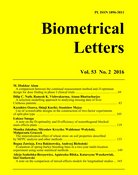
Biometrical Letters Vol. 53(2), 2016, pp. 69-82


The continual reassessment method is a model-based procedure, described in the literature, used to determine the maximum tolerated dose in phase I clinical trials. The maximum tolerated dose can also be found under the framework of D-optimum design, where information is gathered in such a way so that asymptotic variability in the parameter estimates in minimised. This paper investigates the two methods under some realistic settings to explore any potential differences between them. Simulation studies for six plausible dose-response scenarios show that D-optimum design can work well in comparison with the continual reassessment method in many cases. The D-optimum design is also found to allocate doses from the extremes of the design region to the patients in a trial.

Dose finding studies, Phase I trial, Maximum tolerated dose, Continual reassessment method, D-optimum design

